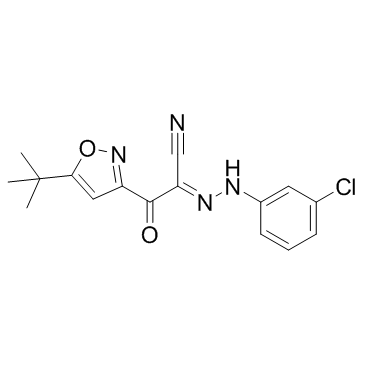| Description |
ESI-09 is a novel noncyclic nucleotide EPAC antagonist with IC50 values of 3.2 and 1.4 μM for EPAC1 and EPAC2, respectively.
|
| Related Catalog |
|
| Target |
IC50: 3.2 μM (EPAC1), 1.4 μM (EPAC2)[1]
|
| In Vitro |
While cAMP competes with 8-NBD-cAMP binding with an IC50 of 39 µM, ESI-09 shows an increased potency with an apparent IC50 of 10 µM. ESI-09 inhibis cAMP-mediated EPAC2 and EPAC1 GEF activity with an IC50 of 1.4 and 3.2µM, respectively. ESI-09 could fit well into the functional cAMP-binding pocket of EPAC1, establishing favorable hydrophobic and hydrogen bonding interactions with the protein’s active-site residues. ESI-09 inhibits 007-AM-stimulated Akt phosphorylation at T308 and S473 in a dose-dependent manner. ESI-09 inhibits pancreatic cancer cells AsPC-1 and PANC-1 migration. ESI-09 inhibits EPAC1-mediated adhesion of PDA cells on collagen I[1]. Exposure to ESI-09 significantly reduces intracellular and total bacterial counts in HUVECs at 30 min postinfection with 10 multiplicities of infection (MOI) of R. australis compared with similarly infected controls[2].
|
| In Vivo |
Treatment with ESI-09 dramatically protects WT mice against R. australis infection with much milder disease manifestations and significantly improves survival[2].
|
| Cell Assay |
INS-1 cells are plated in 96-well plates precoated with polylysine. After overnight incubation, the medium is replaced with Krebs-Ringer bicarbonate (KRB) containing 2.9 mM glucose. After an additional 2-hour incubation, the cells are treated with ESI-09 or DMSO vehicle as a control in fresh KRB containing 11.8 mM glucose for 10 minutes, followed by a 30-minute stimulation with 10 µM 007-AM. The supernatant is collected, and insulin is quantified using an Ultra Sensitive Rat Insulin ELISA kit from Crystal Chem Inc[1].
|
| Animal Admin |
Mice: ESI-09 is dissolved in buffered saline containing 10% (vol/vol) ethanol and 10% (vol/vol) Tween-80. Thirty-three WT C57BL/6 mice are divided into four groups [11 mice (group A), 10 mice (group B), 6 mice each (groups C and D)]. Groups A and C are treated with the Epac-specific inhibitor ESI-09 [10 mg/kg ] via i.p. injection for 5 d before infection, whereas groups B and D are treated with vehicle, followed by i.v. inoculation of R. australis for groups A and B or mock inoculation for groups C and D. ESI-09 or vehicle treatment is continued for another 7 d until mice are killed on day 8. During the course of the experiments, animals are monitored daily for signs of illness and mortality[2].
|
| References |
[1]. Almahariq M, et al. A novel EPAC-specific inhibitor suppresses pancreatic cancer cell migration and invasion. Mol Pharmacol. 2013 Jan;83(1):122-8. [2]. Gong B, et al. Exchange protein directly activated by cAMP plays a critical role in bacterial invasion during fatal rickettsioses. Proc Natl Acad Sci U S A. 2013 Nov 26;110(48):19615-20.
|
